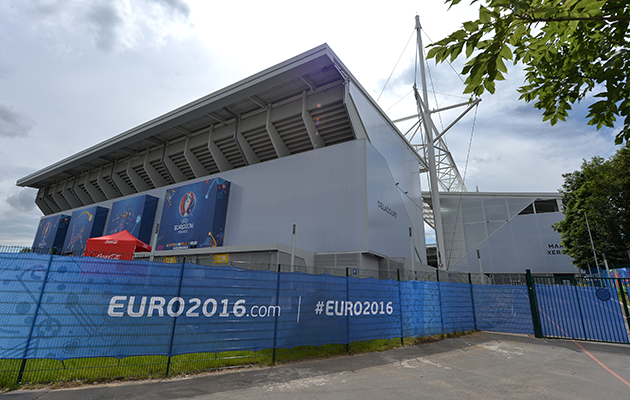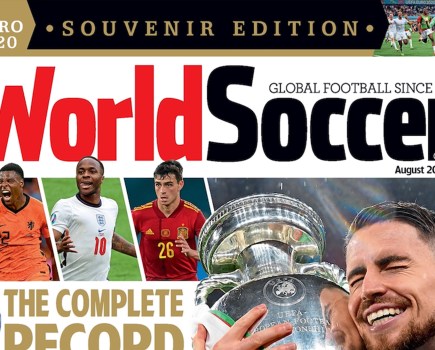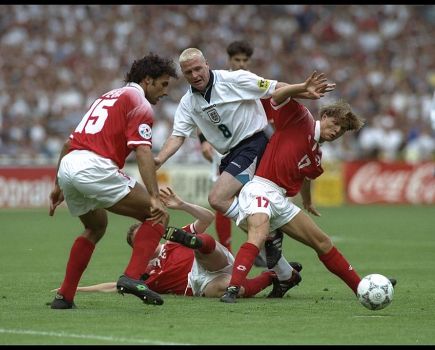Lens is one of 200 soccer cities featured on Libero, the digital travel guide for football fans. Currently featured is a comprehensive, nine-city guide to Euro 2016. Regularly refreshed with new destinations and travelogues, Libero is a one-click treasure trove of football trip tips, tales and trivia.
See www.liberoguide.com
With a stadium completely rebuilt for Euro 2016 and tourists flooding in to visit a new branch of the Louvre, gritty Lens has been revamped – and is the setting for the England-Wales clash of June 16.
An easy shuttle from the Eurostar hub of Lille, the stadium a stroll from the station, Lens already attracts a regular following from the UK.

They’re part of the large and loyal fan base of home club Racing Club, known as the Sang et Or – Blood & Gold.
The club has only won the league once, the same year that the town hosted the World Cup of 1998.
The later departure of iconic winning coach Daniel ‘The Druid’ Leclerq led to a gradual decline. Lens festered in the lower flight.
Promotion in 2014 coincided with the closure of the Stade Bollaert-Delilis for renovation during 2014-15. Abandoning their ground of 41,000 capacity – 5,000 more than the town itself – RCL played home fixtures at nearby Amiens and attracted 70,000 to the Stade de France for games with Paris Saint-Germain and Marseille.
Sadly, mismanagement saw Lens forcibly relegated before they had even begun their top-flight return. A demotivated side finished bottom of La Ligue on points anyway. Now RC Lens are in the second division, aiming for a promotion place – controversially reduced to only two spots this season.
Back in 1998, the fact that bigger neighbours Lille was overlooked as World Cup hosts in favour of this former coal-mining village says mountains for the football tradition here.
It dates back to 1905, when students gathered at the Café Douterlinghe on boulevard des Écoles to form a club. With World War I fought on the doorstep, RC Lens took a while to get going. When they did, it was Félix Bollaert who initiated it. A football-loving local mine owner (whatever happened to them?), Bollaert set to work improving post-1918 conditions of work and leisure for his employees. A football stadium was top priority.

Unveiled in 1933, the Stade Félix-Bollaert took its patron’s name after his death in 1936. The French and Polish anthems were played at the opening ceremony. The local workforce – and local football team – contained a significant number of Poles.
As club and community later fell on hard times, it was André Delilis, local mayor for three decades, who revived both. This modern-day Bollaert had the town council buy the ailing club and persuaded the French footballing authorities to bring Euro 84 to this bleak corner of north-east France. Lens’ crumbling stadium was rebuilt.
Delilis then landed the bigger prize of the World Cup 1998. Sadly, one game saw German hooligans attack police, leaving one officer, Daniel Nivel, in a coma. England fans have a different picture of Lens. It was here that David Beckham made his arrival onto the world stage with a 30-yard free-kick strike against Colombia.
For Euro 2016, the Lens stadium has been renamed after both Bollaert and Delilis, who died 2012. Sadly, second-flight RC Lens won’t be able to repeat their feat of 1998 by winning the French title the same year.
Bearing

The nearest airport to Lens is Lille, 7km (4.5 miles) south of its city centre. An hourly shuttle bus (single €7, return €9) connects with the
Euralille commercial centre in town, journey time 20 mins. Euralille is set between the city’s two train stations, Lille Europe and Lille-Flandres, a short walk apart and close to the centre. Trains to Lens from Lille-Flandres run every 30-60min, journey time 45-50min, tickets around €8-€9.
Lille Europe is a hub for Eurostar services with London St-Pancras.
From Paris Nord to Lens, domestic trains take 1hr 10min, the cheapest tickets around €35.
Lens does have a local bus service but distances between station, stadium and town centre are easily walkable.
For the stadium, turn left out of the station to the end of rue Jean Letienne, cross the main road onto rue Maurice Carton and turn right by the park – the Bollaert-Delilis is ahead of you. Allow 10-15mins.
Taxis stand outside the train station. To call one, contact Ass.Lensoise de Taxi (+33 3 21 28 36 36).
Bed

With the opening of the Louvre-Lens gallery in 2012, Lens has been geared towards tourism. The Tourist Office has a comprehensive database of hotels in the region.
Right by the stadium, the 54-room Hôtel Espace Bollaert is a tasteful three-star with arty touches whose bar offers TV sports and billiards.

Diagonally opposite Lens station, the Hôtel de France (2 place du Général de Gaulle, +33 3 21 28 18 10) is pretty run-down but cheap. Round the corner, le Paris-Brest, taken over by a friendly North-African couple from Paris, is in a similar price bracket, whose owners make up for the relatively basic lodgings on offer. The bar, decorated with a RCL scarf, provides TV sport, the restaurant couscous.

About 4km north of town, the outdoor pool and contemporary furnishings of the homely Lensotel, near the Centre Commercial Lens 2, may make it worth the bother of an out-of-town stay – the nearby Campanile is a bit more basic.
Stadium

The new Stade de Bollaert-Delilis was reopened for the first home match of 2015-16 after its €70 million rebuild. Capacity, a bone of contention among petitioning fans, is now 38,000 – some 3,000 lower than the pre-2014 figure but still more than the population of Lens itself.

The reason is enshrined in the stadium name. Félix Bollaert was head of the local mine company, which in 1929 bought a large patch of land west of the town centre. Despite the discovery of several unexploded grenades from World War I, a stadium was built in four years. Bollaert died in 1936 – a year later Lens reached the top flight.
By the 1970s, with the club cash-strapped and in decline, and the stadium in decay, Lens city council bought the ground for a nominal fee and set about renovating it. It was further developed before hosting Euro 84, which saw the opening of the large East Stand of 20,000 places.
By the early 1990s, capacity had passed 50,000, reduced by 10,000 as the Félix-Bollaert became all-seated for the 1998 World Cup. Three of its stands were knocked down and rebuilt for the occasion, sadly marred by terrible violence for the Germany-Yugoslavia clash.

The €70-million rebuild for Euro 2016 keeps the fiercest home support in the Tribune Marek-Xercès along one sideline. Opposite, the Tribune Lepagnot accommodates VIPs and sponsors. Behind the goal, away fans gather in the Tribune Trannin, home ones in the Tribune Delacourt.
Beer
*Lens has decided to ban the sale of alcohol on match days.*

Bars by Lens stadium remained popular during the rebuild of 2014-15. Supporters’ buses continued to set off from betting bar Le Racing (5 route de la Bassée) – as they have done for 30 years of away travel. It stands near the junction with route de Béthune, where former Le Bollaert pre-match bar is now a Corsican restaurant, Le Maquis. Turn the corner on Béthune and you come to La Mi-Temps (No.24), a real RCL hang-out. A row of scarves over the bar counter complements arty images of local football scenes, with a Jackson Pollock touch. It does cheap lunches, too.
The RCL bar par excellence is Chez Muriel (17 rue Edouard Bollaert), whose landlady has been talking Racing form with regulars for 35 years and counting. The league ladder is faithfully annotated every weekend, while photos and souvenirs testify to past RCL triumphs and European ventures.

In town a short walk away, bars line the main street, boulevard Emile Basly, including football-focused locals’ spot Reinitas (No.94), with RCL match scarves and pennants and a TV for live action. Nearby Les Pirates (No.106) is a late-night spot.

Two expat-friendly pubs stand near a major junction in the town centre: the Irish Tavern is a two-floor spot with daytime opening weekdays and DJs at night; MacEwan’s opens from 4pm and is more sport-oriented.

Of the French haunts, Le Sporting (38 rue de la Gare) had to close in 2014 (anyone want to buy a classic corner bar?), while at the station, La Loco (105 rue Jean Letienne) combines its previous guise of Lens Frites with a burger bar, and large displays of yellow and red.








